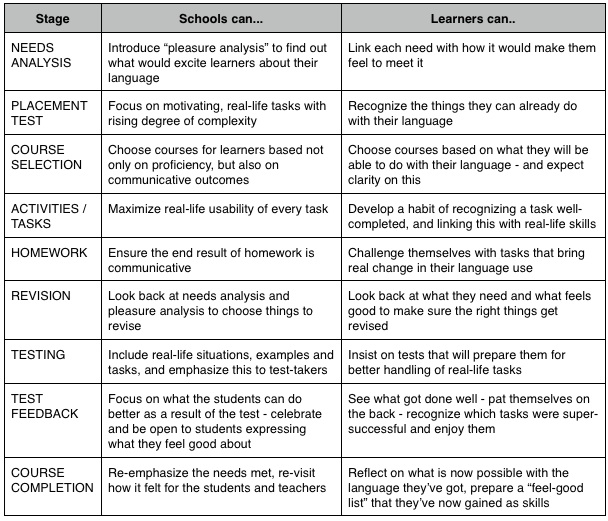This is a rant for now, but I will probably expand this a lot in the future. It started with a quote I learned from one well-known coursebook author, and quickly grew into a liberating – albeit disturbing – idea about foreign language learning. Read on, mull over all this – and tell me if I’m wrong in the comments.
1. Needs and Pleasures of Language Acquisition
One of the joys of my work is that it allows me to meet and work with great people who have done amazing things for language learners and teachers. One such occasion happened on Friday – a teacher training session led by Sue Kay, an ELT author.
And the joyful part? Learning new things and having your mind changed, of course! A lot of ideas and rants I’ve published here stem from something I heard, or read, during my sessions and meetings at work. This time, it’s no different.
Sue finished her presentation with a quote that stuck in my head:
“It is the need to get meanings across and the pleasure experienced when this is achieved that motivates second language acquisition.” (Rod Ellis, 1997)
My teaching, training and learning life has been organised around measuring, testing and finding out the things that need to be done. But how about the other half of the quote?
2. A Few Words About Balance
If your course is all needs and no pleasure – it’s a very efficient course, for sure. It will begin with a needs analysis, then probably will feature lots of testing to make sure that it teaches what it needs to teach. One by one, box by ticked box, your needs will be met, until you are able to convey all the messages you need to convey.
It could be a fun course. But there’s no guarantee.
On the other hand, if your course is all pleasure and no needs – it’s probably a language learning adventure you never want to end. It will feel good all the way, and give you the thrills and the chills of success, and ensure that every bit of feel-good is instilled, designed and taken into account.
Here’s the best part: this course would also need to be focused around needs. Otherwise, the pleasure wouldn’t be there – since you would be getting no kicks out of conveying any meaning, and going nowhere in the end.
Conclusion: the courses focused around needs may end up being fun or dry. And learning languages which is only needs-based may end up being a thrill, or a drag. But designing around pleasure in language learning – at least the way it’s mentioned in the quote above – would also necessarily take needs into account (needs not met = no pleasure).
The question on my mind, then, is this:
Why doesn’t anyone do this?
3. What Gets Measured, Gets Boring
Course design in most schools I know can fail in one of two popular ways.
Failure one: focus on needs only, and seriously measure just the efficiency of meeting needs. This means lots of preparation, emphasis on getting things done, feedback around the mistakes, and testing (lots of testing).
Failure two: separate “study” from “fun” – which means that for most of the time, the language course follows steps laid out in “failure one” above, and then the teacher tries to play a game or watch a funny DVD, or go out on an excursion with a group of demotivated students.
I’m exaggerating, perhaps, but only to prove a point: the link between the need and the pleasure is missing from most foreign language courses I know of. And it’s not through malice or unwillingness to have fun: most schools, teachers and learners are too focused on ticking the boxes, achieving the results and meeting the needs. As a result, they forget to celebrate the places they got to – they forget to enjoy the successes they’ve had – and they fail to design for a place, moment and method of recognizing that pleasant feeling.
4. Language Learning Design for Pleasure
It’s possible to prepare for this nice, warm feeling of accomplishment. Language learners and language teachers can do this together or separately. And I think that this kind of process – bringing the pleasure of foreign language back into classrooms, coursebooks and curriculums – needs to happen at all stages.
Here’s just a few usual stages in a language course:
– Needs analysis
– Placement test
– Programme selection
– Activities / Tasks / Lessons
– Homework
– Revision
– Testing
– Test feedback
– Course completion
There’s nothing inherently pleasant in any of these stages. It’s what you can do – as a language learner, as a tutor or a school manager – that changes this, either into a soul-crushing box-tick stage to pass or into a chance to celebrate and feel good about a language you’re learning.
Let’s take another look.
Like I said – this is a long-term process, and my rant tonight may only have scratched the surface of what’s possible / needed. But it’s a start, at least for me.
5. It’s Your Language You’re Learning, Get The Fun Back!
Guys, this may be important. How do you ensure that the study you’re doing feels good? How do you retain that link between “what I need” and the pleasure you’re getting? Have you seen teachers who still have what it takes to make it happen?
Share it all below. And if you think I’m wrong – tell me as well 🙂
(Photo credit: ![]() Geoffrey Fairchild via Compfight)
Geoffrey Fairchild via Compfight)
Wiktor (Vic) Kostrzewski (MA, DELTA) is an author, translator, editor and project manage based in London. When he works, he thinks about languages, education, books, EdTech and teachers. When he doesn’t work, he probably trains for his next triathlon or drinks his next coffee.
BRAVE Learning (formerly known as 16 Kinds) is a lifelong learning and productivity blog. If you enjoy these posts, please check out one of my books and courses.
My recent publications, and my archive, is now all available on my new project: PUNK LEARNING. Hope to see you there!




One reply on “Pleasure in Language Learning: Account for Your Kicks”
Yep Wiktor, your point 5 hits the nail on the head. It’s only when we have fun and feel satisfied with what we have done that we will want to do more of it. When the opposite happens we want to give up…and unfortunately, most do – many I suspect for this reason.
Of course, as you have said, there are other key factors that will determine success…but this one sits right up there!! 🙂